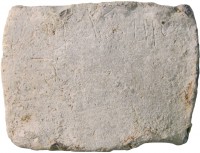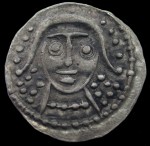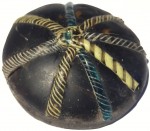 Archaeologists from the University of Sheffield have found an Anglo-Saxon island settlement in Little Carlton, Lincolnshire, that they believe to be one of the most important discoveries in decades. It was metal detectorist Graham Vickers who made the first find: a solid silver stylus. He reported it to Lincolnshire Finds Liaison Officer Dr. Adam Daubney who identified it as a writing implement from the 8th century. It was used to inscribe words on wax tablets; the flat end (which is now bent, probably from an encounter with farming equipment) is an eraser. Pull it through the wax and it resets the field.
Archaeologists from the University of Sheffield have found an Anglo-Saxon island settlement in Little Carlton, Lincolnshire, that they believe to be one of the most important discoveries in decades. It was metal detectorist Graham Vickers who made the first find: a solid silver stylus. He reported it to Lincolnshire Finds Liaison Officer Dr. Adam Daubney who identified it as a writing implement from the 8th century. It was used to inscribe words on wax tablets; the flat end (which is now bent, probably from an encounter with farming equipment) is an eraser. Pull it through the wax and it resets the field.
 A decorated solid silver stylus was a very high status object in the Middle Saxon period. Inspired by his find, Mr. Vickers returned to the plough field and kept detecting, noting the GPS coordinates of every find so the archaeologists who followed him could map out the site. He wound up unearthing hundreds more artifacts: 20 styli, 300 dress pins, more than 100 coins and a very rare lead tablet inscribed with the female Anglo-Saxon name “Cudberg.” Vickers found more than 77 pounds of lead on the site, all relatively common finds. The fact that there’s a name inscribed on this tablet is unusual anyway, and a woman’s name makes it unique.
A decorated solid silver stylus was a very high status object in the Middle Saxon period. Inspired by his find, Mr. Vickers returned to the plough field and kept detecting, noting the GPS coordinates of every find so the archaeologists who followed him could map out the site. He wound up unearthing hundreds more artifacts: 20 styli, 300 dress pins, more than 100 coins and a very rare lead tablet inscribed with the female Anglo-Saxon name “Cudberg.” Vickers found more than 77 pounds of lead on the site, all relatively common finds. The fact that there’s a name inscribed on this tablet is unusual anyway, and a woman’s name makes it unique.
 The coins are all sceats, a type minted in England, and in parts of modern-day Denmark and the Netherlands. Sceats are often found at important trading sites and since they were widely used in northern Europe and have been found in France as well, they were apparently a widely accepted international currency. Most sceats have no inscriptions to record where they were minted and there’s a bewildering variety of iconography. The pictured coin, for example, may not represent any actual king. It seems the minters roughly imitated Roman, Celtic and Germanic coin types because they were their idea of how coins should look.
The coins are all sceats, a type minted in England, and in parts of modern-day Denmark and the Netherlands. Sceats are often found at important trading sites and since they were widely used in northern Europe and have been found in France as well, they were apparently a widely accepted international currency. Most sceats have no inscriptions to record where they were minted and there’s a bewildering variety of iconography. The pictured coin, for example, may not represent any actual king. It seems the minters roughly imitated Roman, Celtic and Germanic coin types because they were their idea of how coins should look.
 Another intriguing find is a glass domed bead made from recycled Roman glass. The core is made of re-melted and reshaped Roman glass. The swirly bars of colored glass on top are very refined and could have only have been made by an expert glass maker. The surface shows signs of abrasion, which could have been done to shape it or mount it. Archaeologists think it’s a gaming counter, but if so it’s a very fancy one and it could be a decorative embellishment from a larger piece like jewelry or a bowl.
Another intriguing find is a glass domed bead made from recycled Roman glass. The core is made of re-melted and reshaped Roman glass. The swirly bars of colored glass on top are very refined and could have only have been made by an expert glass maker. The surface shows signs of abrasion, which could have been done to shape it or mount it. Archaeologists think it’s a gaming counter, but if so it’s a very fancy one and it could be a decorative embellishment from a larger piece like jewelry or a bowl.
The University of Sheffield realized from the quality, number and nature of the finds that Mr. Vickers had stumbled on something remarkable so Dr. Hugh Willmott and graduate student Pete Townend from the Department of Archaeology did geophysical and magnetometry surveys of the site. The data was then 3D modelled so they could better understand how the lay of the land and how it was used in the 7th and 8th centuries.
[youtube=https://youtu.be/2Ne3SmCkTWo&w=430]
The imagery showed that the island they had discovered was much more obvious than the land today, rising out of its lower surroundings. To complete the picture the researchers raised the water level digitally to bring it back up to its early medieval height based on the topography and geophysical survey. […]
Students from the University have subsequently opened nine evaluation trenches at the site which revealed a wealth of information about what life would have been like at the settlement.
They found a number of intriguing items including an area which seems to have been an area of industrial working, as well as very significant quantities of Middle Saxon pottery and butchered animal bone.
Archaeologists believe this wasn’t your average Middle Saxon settlement. So many writing implements, jewels and coins indicate this was a monastery or a center of trade and finance, perhaps part of an international trading network. There are very few surviving documents from this period in Lincolnshire. Reading the artifacts and context of this site will contribute significantly to historical understanding of the area in 8th century.